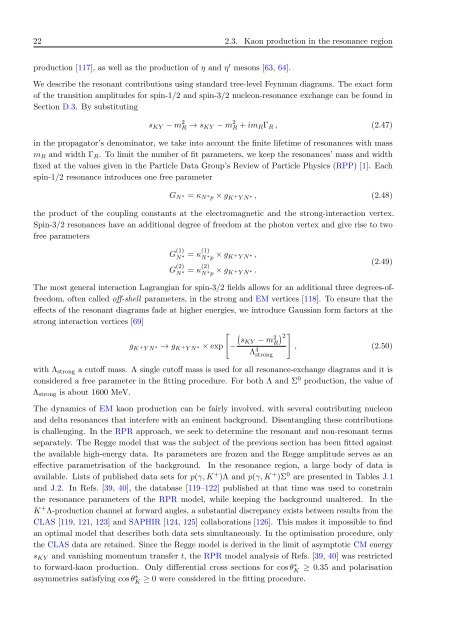Download Thesis in Pdf Format - Theoretical Nuclear Physics and ...
Download Thesis in Pdf Format - Theoretical Nuclear Physics and ...
Download Thesis in Pdf Format - Theoretical Nuclear Physics and ...
Create successful ePaper yourself
Turn your PDF publications into a flip-book with our unique Google optimized e-Paper software.
22 2.3. Kaon production <strong>in</strong> the resonance regionproduction [117], as well as the production of η <strong>and</strong> η ′ mesons [63, 64].We describe the resonant contributions us<strong>in</strong>g st<strong>and</strong>ard tree-level Feynman diagrams. The exact formof the transition amplitudes for sp<strong>in</strong>-1/2 <strong>and</strong> sp<strong>in</strong>-3/2 nucleon-resonance exchange can be found <strong>in</strong>Section D.3. By substitut<strong>in</strong>gs KY − m 2 R → s KY − m 2 R + im R Γ R , (2.47)<strong>in</strong> the propagator’s denom<strong>in</strong>ator, we take <strong>in</strong>to account the f<strong>in</strong>ite lifetime of resonances with massm R <strong>and</strong> width Γ R . To limit the number of fit parameters, we keep the resonances’ mass <strong>and</strong> widthfixed at the values given <strong>in</strong> the Particle Data Group’s Review of Particle <strong>Physics</strong> (RPP) [1]. Eachsp<strong>in</strong>-1/2 resonance <strong>in</strong>troduces one free parameterG N ∗ = κ N ∗ p × g K + Y N ∗ , (2.48)the product of the coupl<strong>in</strong>g constants at the electromagnetic <strong>and</strong> the strong-<strong>in</strong>teraction vertex.Sp<strong>in</strong>-3/2 resonances have an additional degree of freedom at the photon vertex <strong>and</strong> give rise to twofree parametersG (1)N ∗ = κ (1)N ∗ p × g K + Y N ∗ ,G (2)N ∗ = κ (2)N ∗ p × g K + Y N ∗ . (2.49)The most general <strong>in</strong>teraction Lagrangian for sp<strong>in</strong>-3/2 fields allows for an additional three degrees-offreedom,often called off-shell parameters, <strong>in</strong> the strong <strong>and</strong> EM vertices [118]. To ensure that theeffects of the resonant diagrams fade at higher energies, we <strong>in</strong>troduce Gaussian form factors at thestrong <strong>in</strong>teraction vertices [69](g K + Y N ∗ → g K + Y N[−∗ × exp sKY − m 2 2]R), (2.50)Λ 4 strongwith Λ strong a cutoff mass. A s<strong>in</strong>gle cutoff mass is used for all resonance-exchange diagrams <strong>and</strong> it isconsidered a free parameter <strong>in</strong> the fitt<strong>in</strong>g procedure. For both Λ <strong>and</strong> Σ 0 production, the value ofΛ strong is about 1600 MeV.The dynamics of EM kaon production can be fairly <strong>in</strong>volved, with several contribut<strong>in</strong>g nucleon<strong>and</strong> delta resonances that <strong>in</strong>terfere with an em<strong>in</strong>ent background. Disentangl<strong>in</strong>g these contributionsis challeng<strong>in</strong>g. In the RPR approach, we seek to determ<strong>in</strong>e the resonant <strong>and</strong> non-resonant termsseparately. The Regge model that was the subject of the previous section has been fitted aga<strong>in</strong>stthe available high-energy data. Its parameters are frozen <strong>and</strong> the Regge amplitude serves as aneffective parametrisation of the background. In the resonance region, a large body of data isavailable. Lists of published data sets for p(γ, K + )Λ <strong>and</strong> p(γ, K + )Σ 0 are presented <strong>in</strong> Tables J.1<strong>and</strong> J.2. In Refs. [39, 40], the database [119–122] published at that time was used to constra<strong>in</strong>the resonance parameters of the RPR model, while keep<strong>in</strong>g the background unaltered. In theK + Λ-production channel at forward angles, a substantial discrepancy exists between results from theCLAS [119, 121, 123] <strong>and</strong> SAPHIR [124, 125] collaborations [126]. This makes it impossible to f<strong>in</strong>dan optimal model that describes both data sets simultaneously. In the optimisation procedure, onlythe CLAS data are reta<strong>in</strong>ed. S<strong>in</strong>ce the Regge model is derived <strong>in</strong> the limit of asymptotic CM energys KY <strong>and</strong> vanish<strong>in</strong>g momentum transfer t, the RPR model analysis of Refs. [39, 40] was restrictedto forward-kaon production. Only differential cross sections for cos θK ∗ ≥ 0.35 <strong>and</strong> polarisationasymmetries satisfy<strong>in</strong>g cos θK ∗ ≥ 0 were considered <strong>in</strong> the fitt<strong>in</strong>g procedure.















